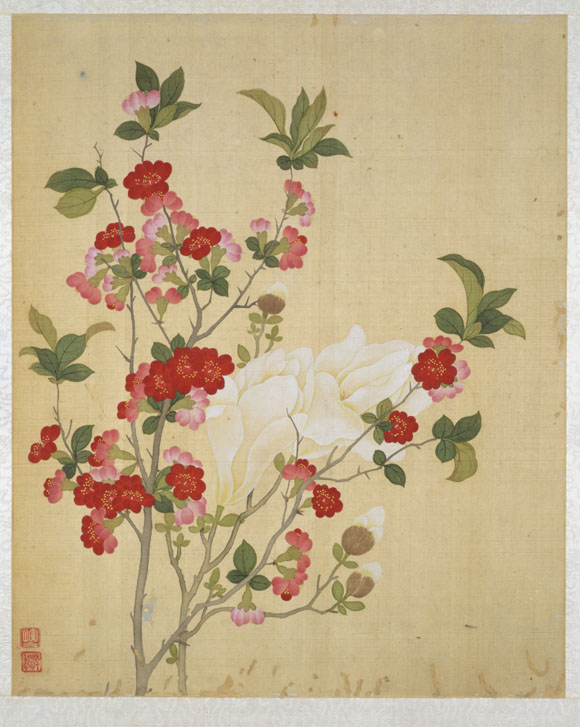Activity
Magnolia and quince, from the Flowers of the Twelve Months: March

Magnolia and quince, from the Flowers of the Twelve Months: March
Many bird and flower paintings, including this album of flowers painted in colors on silk by Yun Bing, were done by women artists. Working in the meticulous gongbi style, she has sought to capture the details that characterize these flowers. The flowers of various colors–pink, red, mauve, and white–are depicted in botanical detail, each petal articulated with its fine veins and fringed tip. Also visible are the sharp zigzag edges of the leaves, the intricacy of their veins, and how they cling tightly to the stems.
While the xieyi depends on swift execution and sure brushstrokes that cannot be altered by additional painting, the gongbi style used here by Yun Bing, requires infinite patience and absolute control of detail. As a form of water color, it too is unforgiving of mistakes. Each element in the picture has been built up slowly by laying down a thin layer of color wash, blending it carefully with a brush dipped in water and, after that has dried, repeating the process until the color is thick and opaque. The white pigment used as the underpainting of the rosy-edged flower was painted on the underside of the silk so that it would be less likely to soften and bleed into the pink pigment applied on the top side of the silk.
In the gongbi style, the elements of the picture are often outlined first with fine, even lines and the areas then filled in with color. In this instance, however, Yun Bing appears not to have drawn the outlines but to have created them by pushing the first layer or layers of color wash delicately outward, so the pooling of the color left a slightly darker line defining the contours. Each stem likewise was outlined by the pooling of the color from the application of one sure, wet stroke. Artists often used charcoal sketches to compose their pictures; perhaps Yun Bing sketched this picture first and followed the lines of her sketch with the color washes.
Although critics, who tended to come from the scholar class, did not respect this art of rich color and fine finish, the style was practiced and enjoyed by other segments of the population, including prosperous merchants, many aristocrats, and the imperial court. Yun Bing’s paintings were much in demand, especially after one which had been given to the Empress Dowager came to the attention of the Emperor, who inscribed it with words of praise. She was a vastly talented artist who was able to turn her keen observations of nature into both highly disciplined, jewel-like works of art such as this album leaf, or loose, joyous color sketches of plants, fish, and insects in their natural settings.




